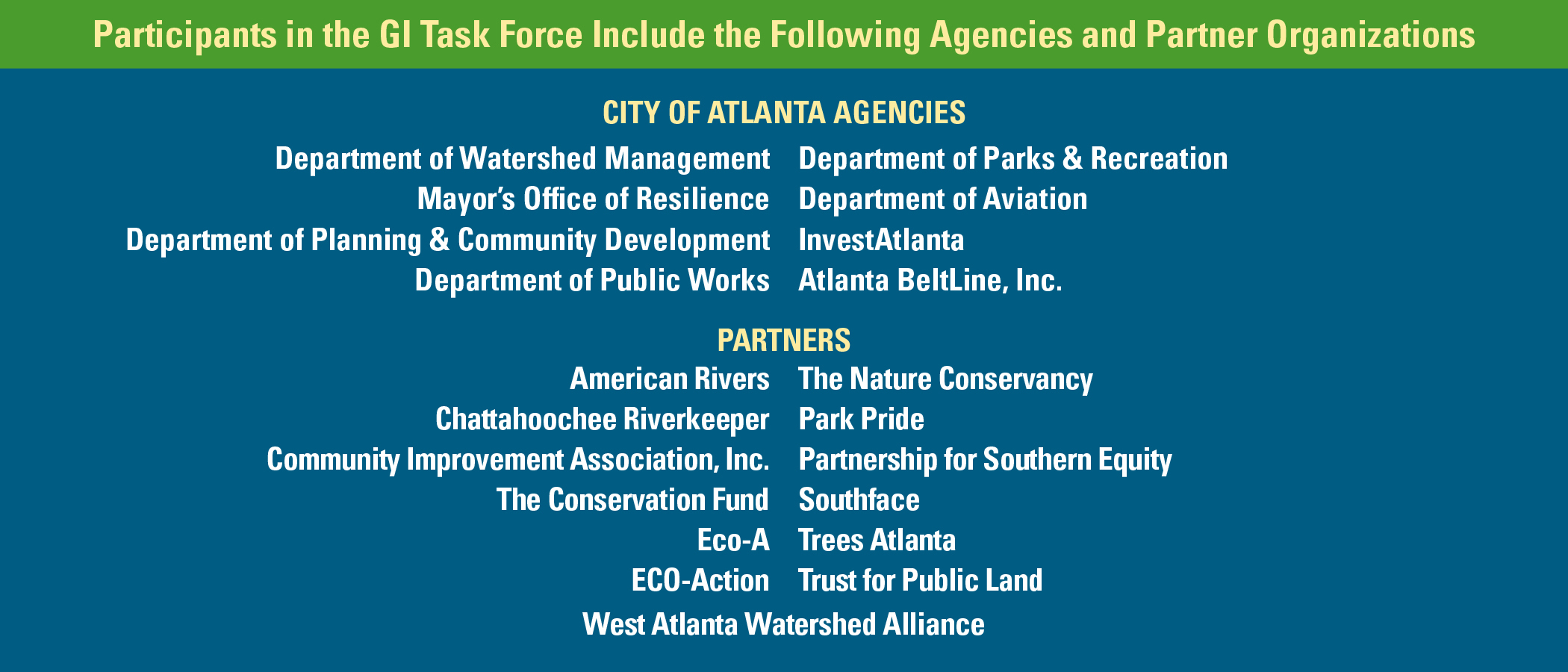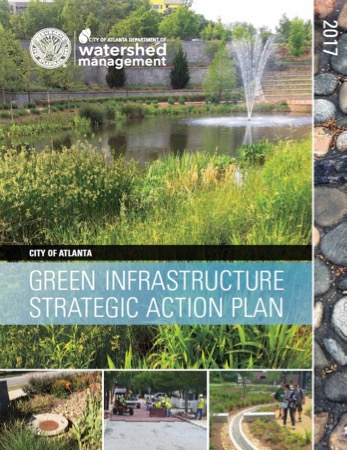Green Infrastructure

The Department of Watershed Management is working to integrate green infrastructure throughout the City. We are doing this by constructing our own projects, regulating private development, and working through the City’s Green Infrastructure Task Force to support green infrastructure projects by other City departments and our partners.

Capacity Relief Pond at Historic Fourth Ward Park


Boone Boulevard Green Infrastructure & Capacity Relief Project


Adair Park Rain Garden

The Challenge of Stormwater
When it rains in a city, impervious surfaces, like rooftops and asphalt, prevent rainwater from soaking into the soil. The resulting stormwater runoff collects litter, oil, excess nutrients from fertilizers, and sediments as it flows across the ground.
Cities have traditionally managed this runoff by draining untreated stormwater into underground pipes and culverts that empty into a nearby stream or river. While these “gray” stormwater systems are important for urban stormwater management and flood control, Green Infrastructure (GI) can decrease demands on gray stormwater systems by reducing the volume and velocity of stormwater runoff.
What is Green Infrastructure?
Green Infrastructure (GI) is an approach to stormwater management that reduces the volume of polluted runoff from entering our streams and pipe systems. GI systems such as rain gardens, green roofs, and cisterns are designed to capture and treat the first flush by slowing down stormwater runoff and allowing it to slowly infiltrate, evaporate, or be harvested for reuse. GI systems typically feature amended soils, stones, and plants that replicate the natural drainage systems of undeveloped land. GI can also include planning approaches such as forest conservation and restoration, urban tree preservation and impervious cover reduction.


Benefits of GI
Green infrastructure provides many benefits for communities:
• Removes pollution
• Improves water quality
• Reduces the volume, velocity, and temperature of stormwater runoff
• Beautifies the community
• Strengthens the local economy
• Enhances infrastructure resiliency
Beyond reducing the impacts of stormwater and protecting our waterways, green infrastructure can also improve air quality, ease urban heat, and create habitat for pollinators and wildlife.
What Can You Do
Everyone can help reduce the impacts of stormwater.
At Home
• Install a rain barrel, plant a tree, or redirect your downspout into a rain garden
• Use porous concrete or permeable pavers as an alternative to concrete for walkways and patios
• Landscape your yard using native plants and pollinator species to help build a more resilient neighborhood. Native plants are better adapted to our soils and climate and require less irrigation.
• You may already have green infrastructure in your yard if your home was built after 2013.
Resource: Review “Green Infrastructure for Single Family Residences: COA Stormwater Guidelines” at atlantawatershed.org
In Your Community
Support projects proposed in your neighborhood such as permeable pavers, bioswales, and stormwater planters for community improvements.
Want to learn more about GI? Review the City’s Green Infrastructure Brochure
Want to visually learn more about GI? View the City’s Green Infrastructure story map here.

The Lionel Hampton-Beecher Hills Nature Preserve protects over 200 acres of the Utoy Creek watershed.

Projects
Green infrastructure is popping up all over town! The permeable paver-lined streets in Peoplestown, the pond at Historic Fourth Ward Park, and the rain garden at Lindsay Street Park are all examples of new ways the City is building its infrastructure to better manage stormwater runoff. We also want to highlight private developments that are doing great green infrastructure.
Development Regulations
The City of Atlanta requires green infrastructure on new development and redevelopment, including both commercial properties and single-family homes. Head to our Post-Development Stormwater Management page for information, checklists, and guidance documents.
Green Infrastructure Task Force
The Department of Watershed Management has convened staff from several City departments and external partners to come up with ways to optimize both public and private infrastructure investments—buildings, streets, sidewalks, parks, etc.–by incorporating green infrastructure for stormwater management.


Green Infrastructure Strategic Action Plan
This Strategic Action Plan has been developed by the GI Task Force to serve as a comprehensive action plan for City-wide GI implementation: addressing institutional and funding barriers, increasing effectiveness, and engaging multiple city departments, citizens, the development community, and environmental groups in working towards GI implementation. Also see our Green Infrastructure Guide.
Green Infrastructure Brown-bag Lunch Meetings
Green Infrastructure Brown-Bag sessions are held regularly to discuss Green Infrastructure topics of interest. Click here to join our mailing list to receive notices.
Our Address
Department of Watershed Management Administrative Offices
72 Marietta Street NE
Mon-Fri – 8:15 am to 5:00 pm
City Directory
Need to contact another city department?


